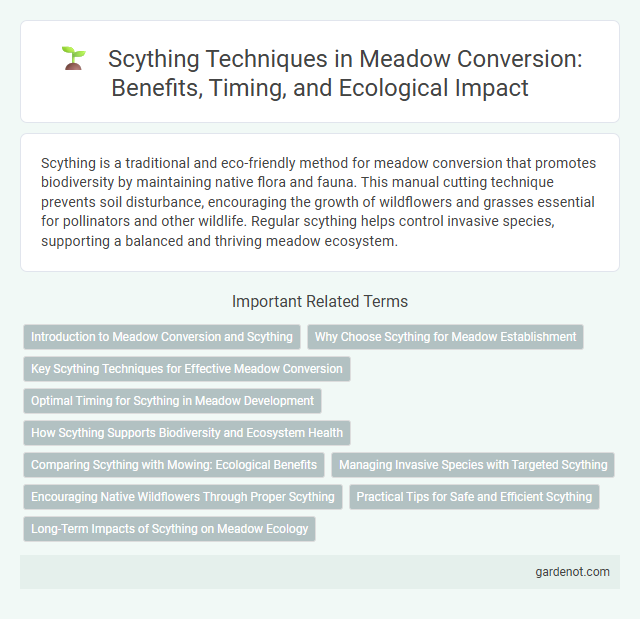Scything is a traditional and eco-friendly method for meadow conversion that promotes biodiversity by maintaining native flora and fauna. This manual cutting technique prevents soil disturbance, encouraging the growth of wildflowers and grasses essential for pollinators and other wildlife. Regular scything helps control invasive species, supporting a balanced and thriving meadow ecosystem.
Introduction to Meadow Conversion and Scything
Meadow conversion involves transforming arable land or degraded fields into biodiverse grasslands rich in native species, enhancing soil health and supporting pollinators. Scything plays a crucial role in this process by providing a low-impact, precise method to cut grasses and wildflowers, encouraging natural regeneration without harming soil structure. This traditional technique supports sustainable meadow management by maintaining plant diversity and preventing nutrient overload that modern machinery might cause.
Why Choose Scything for Meadow Establishment
Scything promotes sustainable meadow establishment by minimizing soil disturbance and preserving native flora and fauna. This traditional method enhances biodiversity and improves soil health without the use of heavy machinery or chemicals. Choosing scything supports eco-friendly land management while maintaining the natural balance of meadow ecosystems.
Key Scything Techniques for Effective Meadow Conversion
Mastering key scything techniques, such as maintaining consistent blade angle and using smooth, rhythmic strokes, enhances the efficiency of meadow conversion by ensuring clean, even cuts that promote regrowth. Proper posture and controlled arm movement reduce fatigue, allowing for longer, more effective scything sessions essential for large-scale meadow management. Regular sharpening of the scythe blade is critical to maintaining cutting performance and preventing damage to native grasses and wildflowers during meadow restoration.
Optimal Timing for Scything in Meadow Development
Optimal timing for scything in meadow development is crucial to maximize biodiversity and promote healthy regrowth. Scything during late summer, typically from mid-July to early August, allows most wildflowers to set seed while preventing dominant grasses from outcompeting less vigorous species. Regularly timed scything cycles help maintain a diverse plant structure, supporting a wide range of insects and wildlife throughout the growing season.
How Scything Supports Biodiversity and Ecosystem Health
Scything promotes biodiversity by enabling low-impact meadow management that preserves native flora and fauna, avoiding soil compaction and habitat disruption common with mechanized mowing. This traditional technique supports a diverse ecosystem by allowing a gradual regrowth of plants, which provides continuous food sources and shelter for pollinators, insects, and small wildlife. Maintaining meadow health through scything enhances nutrient cycling and soil quality, fostering resilient ecosystems that thrive season after season.
Comparing Scything with Mowing: Ecological Benefits
Scything promotes biodiversity by preserving insect habitats and avoiding soil compaction, unlike mowing which often destroys ground cover and disrupts wildlife. The manual technique removes cut plants efficiently, allowing organic matter to remain and support soil health. By reducing noise and emissions, scything offers a sustainable alternative that aligns with ecological meadow management goals.
Managing Invasive Species with Targeted Scything
Targeted scything effectively manages invasive species by selectively cutting unwanted plants before they set seed, preventing their spread and preserving native meadow biodiversity. Regular timing of scything during growth peaks weakens invasive species, giving native flora a competitive advantage. This method supports sustainable meadow conversion by enhancing habitat quality without relying on chemical controls.
Encouraging Native Wildflowers Through Proper Scything
Scything promotes the growth of native wildflowers by preventing invasive grasses from dominating meadows, allowing diverse flora to thrive. Timing scything to occur after wildflowers have seeded ensures natural regeneration and maintains healthy plant populations. Regular, careful scything supports meadow biodiversity and enhances habitat quality for pollinators like bees and butterflies.
Practical Tips for Safe and Efficient Scything
Use a sharp, well-maintained blade to ensure clean cuts and reduce physical effort during meadow scything. Maintain a consistent posture with relaxed arms and a slight bend in the knees to prevent fatigue and injury. Clear the area of obstacles before starting to enhance safety and efficiency while mowing.
Long-Term Impacts of Scything on Meadow Ecology
Scything promotes meadow biodiversity by preventing scrub encroachment and maintaining varied plant structures, which support diverse insect populations over time. Regular scything helps sustain soil health through minimal disturbance, enhancing nutrient cycling and microbial activity vital for ecosystem resilience. Long-term scything regimes contribute to the preservation of native flora and fauna, fostering ecological balance and reducing reliance on mechanical or chemical interventions.
Scything Infographic

 gardenot.com
gardenot.com